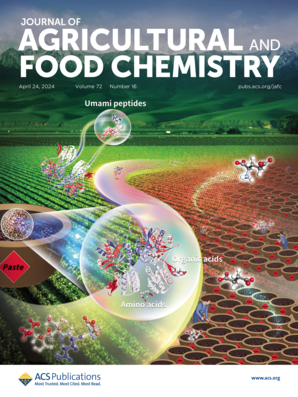Systematic Engineering of Eriodictyol-7-O-glucoside Biosynthetic Pathway through Enzyme Screening and Gene Regulation
IF 5.7
1区 农林科学
Q1 AGRICULTURE, MULTIDISCIPLINARY
引用次数: 0
Abstract
The natural product eriodictyol-7-O-glucoside is more water-soluble and stable than eriodictyol and also exhibits novel biological activities and functions. However, its biosynthesis is hindered by the limited catalytic efficiency of key enzymes. Furthermore, the intricate interplay between cell growth and UDP-glucose supply adds another layer of complexity, rendering the engineering of productive strains challenging. To address this challenge, we introduced a novel “top-down” strategy in which bioinformatics analysis was initially used to identify six specific flavonoid 7-O-glucosyltransferases uniquely capable of converting eriodictyol into its 7-O-glucoside derivative. By manipulation of the plasmid copy number and promoter strength, the expression levels of the most promising flavonoid 7-O-glucosyltransferases from Arabidopsis thaliana were precisely fine-tuned, resulting in a remarkable 66.16% increase in eriodictyol-7-O-glucoside production. To improve the enhancement process, we focused on the overexpression of two pivotal enzymes: phosphoglucose mutase (encoded by the pgm gene) and UDP-glucose pyrophosphorylase (encoded by the galU gene). This strategic step was implemented to significantly increase the availability of glycosylation donors. Moreover, the eriodictyol concentration was increased to ensure ample feedstock. Finally, through comprehensive optimization of the fermentation conditions, eriodictyol-7-O-glucoside production was substantially enhanced, with a staggering 1187.36 mg L–1 obtained (molar conversion rate: 94.99%) at a substrate titer of 800 mg L–1 eriodictyol after 48 h of fermentation. The best engineered strain produced 2.70 g L–1 of eriodictyol-7-O-glucoside in a 5 L bioreactor. This study provides an effective and sustainable method for the high-yield production of flavonoid glycoside derivatives.

基于酶筛选和基因调控的碘二醇-7- o -葡萄糖苷生物合成途径系统工程
天然产物环二醇-7- o -葡萄糖苷比环二醇具有更好的水溶性和稳定性,并表现出新的生物活性和功能。然而,关键酶的催化效率有限,阻碍了其生物合成。此外,细胞生长和udp -葡萄糖供应之间错综复杂的相互作用增加了另一层复杂性,使生产菌株的工程具有挑战性。为了解决这一挑战,我们引入了一种新的“自上而下”策略,其中生物信息学分析最初用于鉴定六种特定的类黄酮7- o -葡萄糖基转移酶,这些酶独特地能够将碘二醇转化为其7- o -葡萄糖苷衍生物。通过控制质粒拷贝数和启动子强度,对拟南芥中最有前途的类黄酮7- o -葡萄糖基转移酶的表达水平进行了精确微调,使拟南芥中7- o -葡萄糖基转移酶的产量提高了66.16%。为了改善增强过程,我们重点研究了两个关键酶的过表达:磷酸葡萄糖突变酶(由pgm基因编码)和udp -葡萄糖焦磷酸化酶(由galU基因编码)。实施这一战略步骤是为了显著增加糖基化供体的可获得性。此外,还增加了周期醇的浓度,以保证充足的原料。最后,通过对发酵条件的综合优化,大大提高了碘二醇-7- o -葡萄糖苷的产量,在底物滴度为800 mg L-1的条件下,发酵48 h后得到了惊人的1187.36 mg L-1(摩尔转化率为94.99%)。最佳工程菌株在5l的生物反应器中产生2.70 g L - 1的碘二醇-7- o -葡萄糖苷。本研究为黄酮类苷衍生物的高产生产提供了一种有效、可持续的方法。
本文章由计算机程序翻译,如有差异,请以英文原文为准。
求助全文
约1分钟内获得全文
求助全文
来源期刊
CiteScore
9.90
自引率
8.20%
发文量
1375
审稿时长
2.3 months
期刊介绍:
The Journal of Agricultural and Food Chemistry publishes high-quality, cutting edge original research representing complete studies and research advances dealing with the chemistry and biochemistry of agriculture and food. The Journal also encourages papers with chemistry and/or biochemistry as a major component combined with biological/sensory/nutritional/toxicological evaluation related to agriculture and/or food.

 求助内容:
求助内容: 应助结果提醒方式:
应助结果提醒方式:


